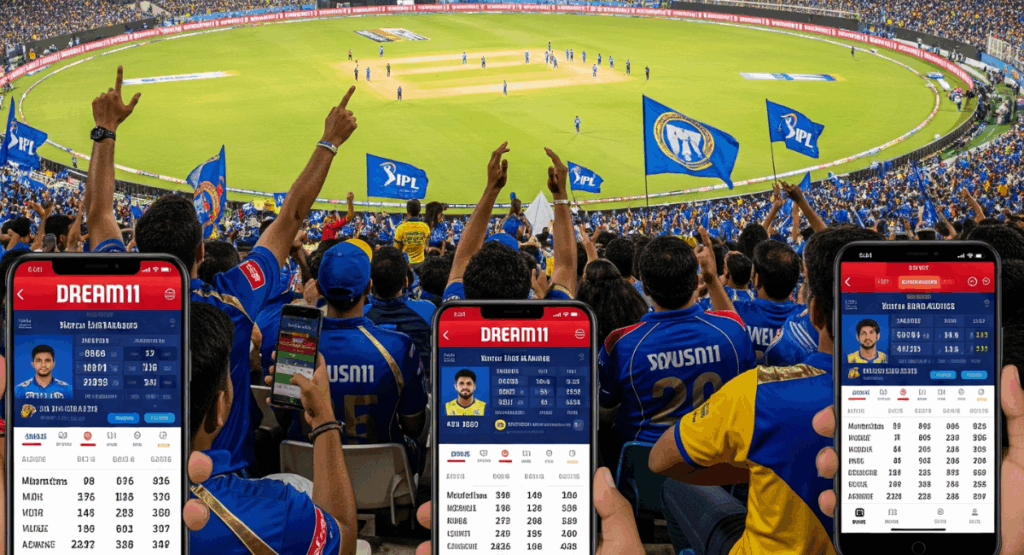
Engagement & Viewership in the Absence of Fantasy Apps has become a critical area of study in the world of sports and digital entertainment. Fantasy apps have long been credited with boosting fan interaction, creating excitement, and keeping audiences invested in every match. However, understanding how engagement and viewership behave when these apps are not in play can reveal deeper insights into genuine fan loyalty, content consumption habits, and alternative ways to sustain audience interest.
In the summer of 2025, India’s Lok Sabha passed the Online Gaming Bill, effectively banning real-money gaming platforms, including popular fantasy sports apps like Dream11 and My11Circle. Fantasy sports, once hailed as a “game of skill,” had transformed how millions engaged with cricket, kabaddi, football, and other sports. With the ban now in force, we’re witnessing a seismic shift in fan behavior, sponsorship dynamics, and overall viewership.
Fantasy Apps Sports Engagement Pre-Ban
Before the 2025 ban, fantasy sports apps were more than just games; they were engagement engines. Platforms like Dream11 allowed fans to build virtual teams, predict outcomes, and win cash prizes based on real-world performances. This interactive layer turned passive viewers into active participants, boosting emotional investment in matches.
In India, where cricket reigns supreme, fantasy apps were credited with skyrocketing viewership during events like the Indian Premier League (IPL). A pre-ban survey indicated that fantasy participation correlated with higher TV and streaming hours, as fans tuned in not just for their favorite teams but to track individual player stats. For instance, during IPL seasons, fantasy users reported watching 20-30% more games, driven by the stakes involved.
Beyond cricket, these apps democratized engagement across sports. Kabaddi leagues saw a surge in popularity, with viewership crossing 200 million, partly fueled by fantasy platforms. Even niche sports benefited, as apps introduced fans to new leagues through promotions and easy entry points. Economically, the industry was booming: Valued at $1-1.2 billion in 2024, it was projected to hit $2-2.6 billion by 2030, with cricket driving 85-90% of revenues. Sponsorships poured in, funding grassroots programs, women’s sports, and athlete endorsements.
Industry Fallout due to the ban
The Online Gaming Bill 2025, passed amid concerns over addiction and illegal practices, classified real-money fantasy as gambling, leading to shutdowns by major players like Dream Sports and MPL. Startups scrambled, with some pivoting to subscription models, but revenues plummeted. The ban threatens over 100,000 jobs and billions in enterprise value.
Public reaction on social media was swift and divided. Many lamented the loss of a “hobby” that blended skill and excitement, while others warned of unintended consequences like a rise in illegal betting.
Diminished Engagement: From Active Participants to Passive Spectators
Without fantasy apps, the emotional and interactive tie fans have to sports has taken a hit. Pre-ban, the “high-stakes” thrill kept users glued, but now, that direct involvement is gone. Fans who once analyzed player form, weather conditions, and pitch reports for their teams are reverting to casual watching.
Early indicators show a dip in social media interactions around matches. Social media discussions on fantasy strategies have dwindled, replaced by broader complaints about the ban’s impact. Smaller leagues, reliant on fantasy-driven hype, face the brunt: Without sponsorships, events like local cricket tournaments or women’s leagues struggle to attract crowds or online buzz.
On the flip side, some argue this could purify fandom, focusing on the sport itself rather than monetary gains. However, critics point out that engagement tools like fantasy bridged generational gaps, teaching strategy and research to younger fans.
Viewership Under Pressure: Numbers Tell the Story
Viewership metrics are already signaling trouble. Post-ban, initial reports suggest a potential 10-20% drop in IPL streaming hours, as fans lose the incentive to follow every ball. The Board of Control for Cricket in India (BCCI) could see significant revenue declines, given fantasy’s role in boosting ad spends and broadcast rights.
Comparatively, global trends echo this: In regions with restricted betting, sports viewership often stabilizes but grows more slowly without interactive boosts. In India, where fantasy accounted for a “cultural layer” of sports, the absence might push viewers toward shorter formats or highlights, reducing full-match watches.
Media outlets and OTT platforms, previously buoyed by fantasy ad dollars, now face a “revenue gap.” While telecom and FMCG brands might fill the void, the transition could lead to short-term slumps in sports broadcasting.
| Aspect | Pre-Ban Impact | Post-Ban Impact |
| Viewership Growth | 20-30% boost from users | 10-20% decline in hours watched |
| Sponsorship Revenue | $1B+ industry funding leagues | Significant cuts for niche sports |
| Fan Interaction | High (strategies, communities) | Lower (passive viewing) |
| Illegal Alternatives | Low (legal options available) | Rise in offshore betting |
Risks, Alternatives, and the Road Ahead
The ban’s downsides extend beyond engagement and viewership. Experts warn of a surge in illegal betting and offshore apps, potentially exacerbating the very issues the law sought to address. Sports development suffers too, with reduced funding for grassroots and women’s initiatives.
Alternatives are emerging: Free-to-play fantasy modes, skill-based esports, or subscription apps without cash prizes. Globally, regulated models in the US show how fantasy can coexist with safeguards, but India’s strict stance might inspire similar bans elsewhere. Influencers and creators, once reliant on referral codes, must pivot, potentially enriching content with deeper analysis over promotions.
conclusion
The 2025 ban on fantasy apps marks the end of an era where sports and gaming blurred lines, driving unprecedented engagement & viewership in the absence of fantasy apps. While aimed at protection, it risks stunting India’s sports economy and pushing activities underground. As fans adapt, the true test will be whether pure passion can fill the void left by fantasy’s adrenaline. For now, the field feels a little emptier, but perhaps that’s an opportunity for authentic fandom to shine.

